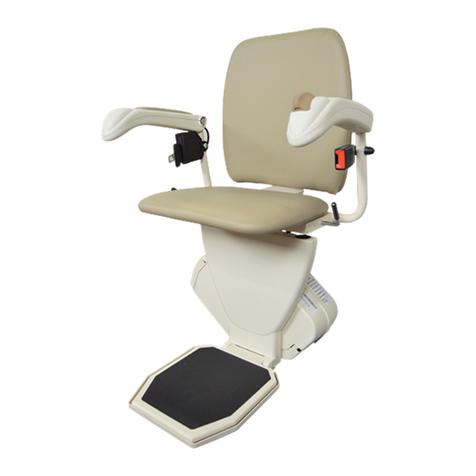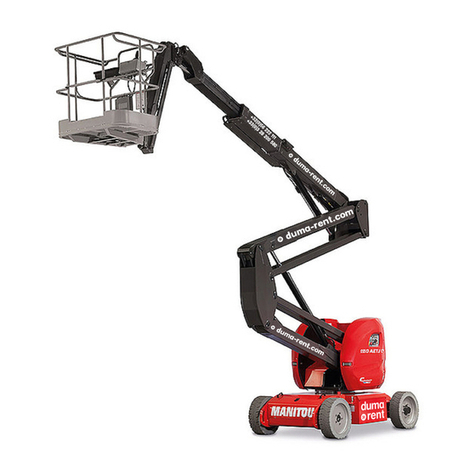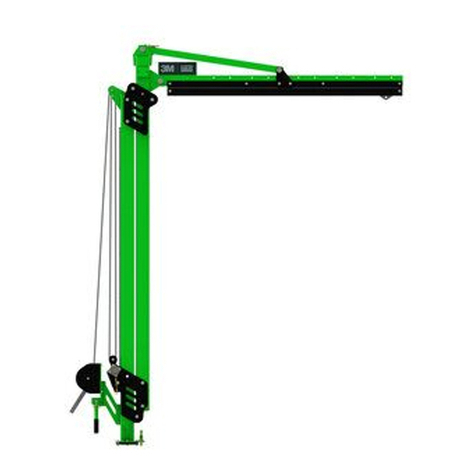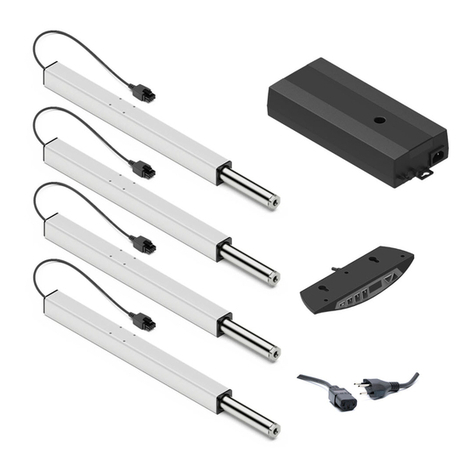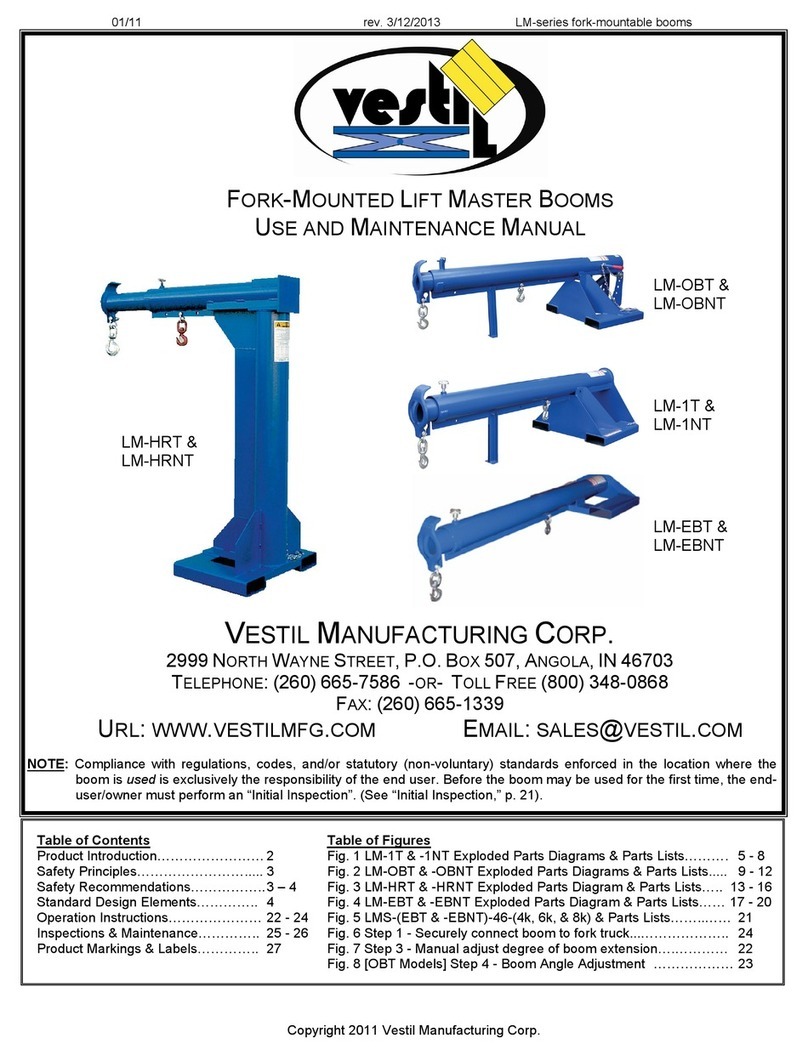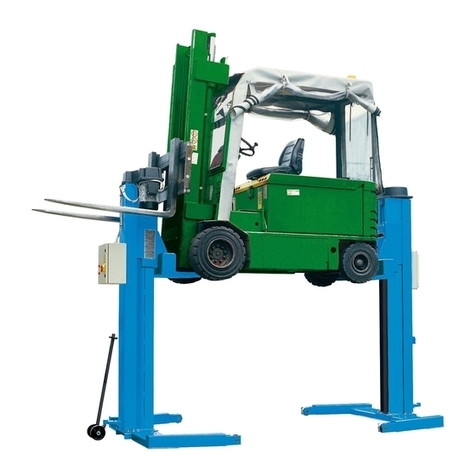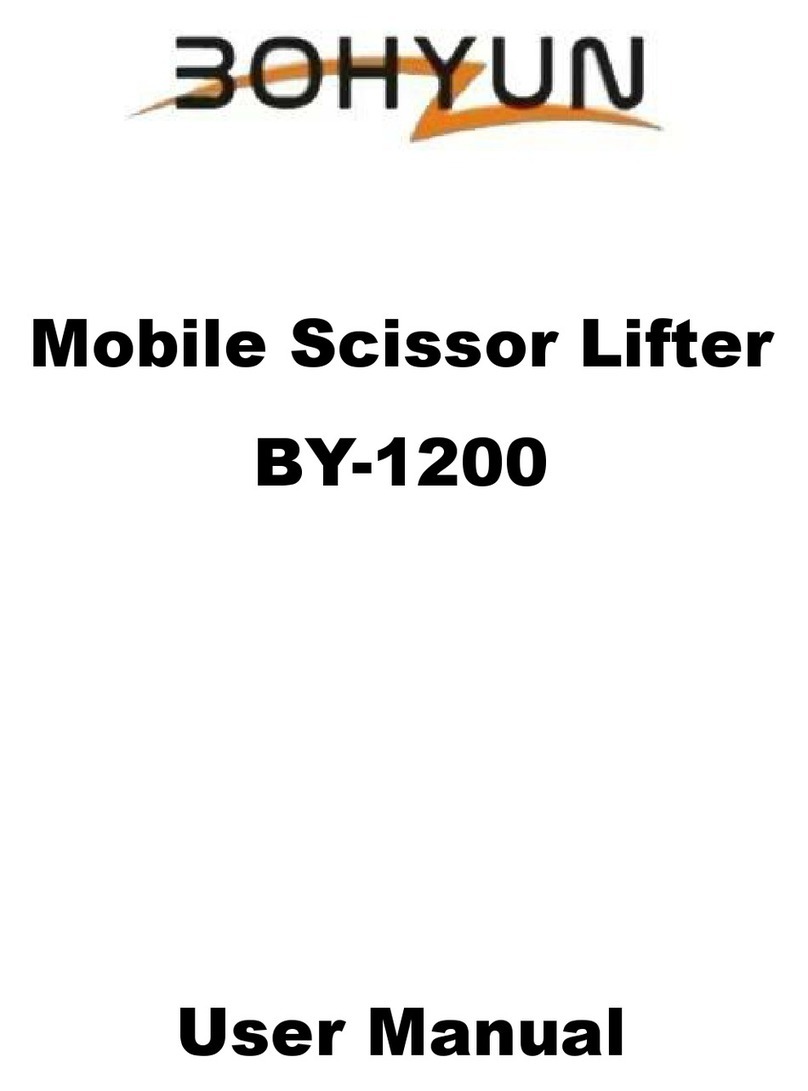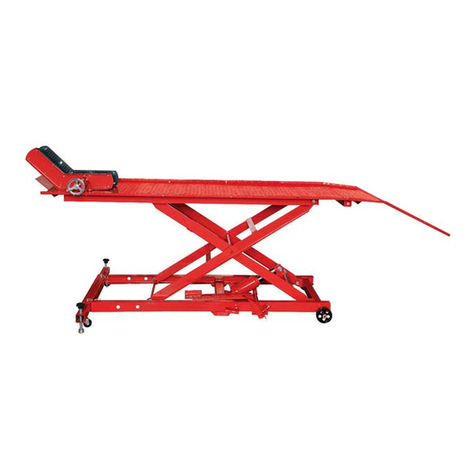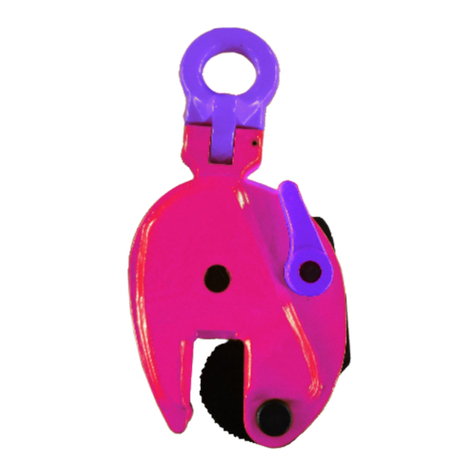MAKINEX PHT-40 User manual

Rev 0917

Page 2of 37
CONTENTS
FORWARD ................................................................................................................ 3
DISCLAIMER............................................................................................................. 3
1. INTRODUCTION.................................................................................................... 4
2. SAFETY INFORMATION....................................................................................... 5
2.1 Training............................................................................................................. 5
2.2 Preparation ....................................................................................................... 5
2.3 Operation.......................................................................................................... 5
2.4 Maintenance and Charging............................................................................... 6
2.4.1 Adjusting brakes ..................................................................................... 6
2.4.2 Securing nose hook onto jib ................................................................... 9
3. OPERATION........................................................................................................ 11
3.1 Controls/Layout............................................................................................... 11
3.2 General........................................................................................................... 12
3.2.1 Control Hook Reach................................................................................. 12
3.2.2 Control Hook Lateral Movements............................................................. 12
3.2.3 Lift and Lower Powered Lifting Arm ......................................................... 12
3.2.4 Steering while unloaded........................................................................... 13
3.2.5 Loading and unloading at ground level .................................................... 14
3.2.6a Hook Operation ...................................................................................... 15
3.2.6b Hook Operation ...................................................................................... 16
3.2.7 Operating Brakes ..................................................................................... 17
3.2.8 Ground Conditions ................................................................................... 18
3.2.9 Transporting load across ground.............................................................. 18
3.3 Lift Technique ................................................................................................. 19
3.3.1 Raising & lowering load............................................................................ 19
3.3.2 Loading & Unloading at height ................................................................. 20
3.3.3 Increased Risk Position............................................................................ 22
3.3.4 Topple Scenario ....................................................................................... 22
3.4 Charging ......................................................................................................... 23
3.5 Power failure unload procedure...................................................................... 23
3.6 Transport and Storage.................................................................................... 24
4. LOAD AND REACH DATA.................................................................................. 26
5. SLOPE GUIDE..................................................................................................... 27
6. QUICK REFERENCE HAZARD ASSESSMENT ................................................. 28
7. SAFETY AND INSTRUCTION DECAL................................................................ 30
8. TECHNICAL DATA AND SPECIFICATIONS ...................................................... 30
9. DECLARATION OF CONFORMITY .................................................................... 33
10. LIMITED WARRANTY ....................................................................................... 34
WARRANTY: (Ex-factory/ Reseller premise)........................................................ 34
Warranty exclusions: ............................................................................................ 35
Normal Wear ........................................................................................................ 35
Installation, Use and Maintenance........................................................................ 35
Other Exclusions................................................................................................... 35
Responsibility of the consumer under this Limited Warranty: ............................... 35
Claim Procedure:.................................................................................................. 35
CONTACT INFORMATION ..................................................................................... 37

Page 3of 37
FORWARD
Thank you for purchasing a MAKINEX product.
This manual provides information and procedures to safely operate and maintain the
PHT-140 device. For yours and/or other’s safety and protection from injury, carefully read,
understand and observe the safety instructions described in this manual.
Keep this manual or a copy of it with the machine. If you lose this manual or need an
additional copy, please contact MAKINEX. This machine is designed and built with user
safety in mind; however, it can present hazards if improperly operated and/or serviced.
Please follow the operating instructions carefully. If there are any questions regarding
operating or servicing of this machine, please contact MAKINEX.
The information contained in this manual was based on machines in production at the time
of publication. MAKINEX reserves the right to change any portion of this information without
notice.
All rights, especially copying and distribution rights are reserved.
Copyright 2017 by MAKINEX
No part of this publication may be reproduced in any form or by any means, electronic or
mechanical, including photocopying, without express written permission from MAKINEX.
Any type of reproduction or distribution not authorised by MAKINEX represents an
infringement of valid copyrights and will be prosecuted. We expressly reserve the right to
make technical modifications, without due notice, which aim at improving our machines or
their safety standards.
DISCLAIMER
Makinex and its affiliates take no responsibility for any damage, injury or death resulting
from the incorrect or unsafe use of this product. Use of this product should be
undertaken by competent persons only. It is the operator’s responsibility to ensure that
the following safety procedures are followed. If you are unsure, do not operate this
product.

Page 4of 37
1. INTRODUCTION
The PHT-140 device is a hand truck with a powered lifting arm which can be fitted with
various attachment tools. The basic PHT-140 device is configured in combination with a
hook attachment fitted to the lifting arm. Typically, the device is used for loading small
machinery fitted with a lifting eye onto or off vehicles –such as a generator or pressure
washer onto a Ute. Operated by a single user, items of up to 140kg (120kg for all other
attachments) can be ergonomically transferred from ground height to bench height and vice
versa as well as transported across the ground as with traditional hand trucks. Because of
this capability, the PHT-140 device is a powerful, practical and versatile tool which can be
used to reduce the risks of back injury involved in awkward two or three-man lifts and without
the inherent unwieldiness of large plant like a Forklift.
This operator’s manual provides an important guide to using the PHT-140 device safely. As
with most wheeled Hand Trucks and Wheelbarrows the PHT-140 device is “user-stabilized”
while in use. This is not a “walk behind machine” like a counterbalanced pallet stacker or
straddle stacker which operate on “dead man control” principles. With user-stabilized hand
trucks, or even when moving a load with your own hands, load stability depends on load
awareness and active load management by the user in response to the feel of the load. For
example –in circumstances of managing heavier loads, the user is warned about higher risk
by a feeling of increasing force required to control the handles. Increased caution and slower
movements should then be exercised.
The instructions contained in this guide will inform the user about considerations such as
handling technique, safe ground slope limits, machine tilt and height limits and load weight
limits. When used correctly the PHT-140 device is a powerful enhancer of your own body’s
manual handling versatility.

Page 5of 37
2. SAFETY INFORMATION
2.1 Training
•To access PHT-140 training video scan QR code
or go to www.youtube.com/watch?v=MN5TgT-I49I
•All operators should be trained. The owner is responsible for training the users.
•Never let children or untrained people operate or service the equipment.
•The owner/user can prevent and is responsible for accidents or injuries occurring to
himself or herself, other people or property.
•Read the Operator’s Manual, attachment manuals, and other training material. If the
operator(s) can’t read English, it is owner’s responsibility to explain this to them.
•Become familiar with the safe operation of the equipment, operator’s control, and
safety signs.
2.2 Preparation
•Check brakes are operating.
•Inspect machine for deformation damage.
•Check battery power level using the indicator button on the battery.
•Evaluate the terrain to determine what accessories and attachments are needed to
properly and safely perform the lift and/or translation of the load. Only use
accessories and attachments approved by the manufacturer.
•Check terrain to determine slope + ground condition suitability.
•Try to avoid slopes.
•Wear appropriate Personal Protective Equipment (PPE) clothing; long pants and
safety shoes.
•Warn bystanders of planned operation to stay clear.
2.3 Operation
•Keep bystanders away.
•Only operate in good light, keeping away from holes and hidden hazards.
•Do not operate machine in slippery environment.
•Do not operate the machine under the influence of alcohol or drugs.
•Remove obstacles from work area, watch for holes, ruts, or bumps and make sure
work area is free of clutter.
•Only operate the machine from behind the handles with each hand on a respective
handle, thus avoiding potential pinch or crush injuries.
•Do not exceed the rated lifting capacity –140kg (120kg for all other attachments).
•Understand the LOAD DATA page and operate within comfortably manageable limits
–the PHT-140 device’s capacity should never be more than comfortably manageable
by user and always less than or equal to 140kg (120kg for all other attachments).

Page 6of 37
•Do not lift an item bulky enough to hit the lift arm in lifted position - some fixed lifting
eyes may be positioned so that parts of the load hit the lift arm in raised position.
•Do not lean beyond balanceable point for user as per training procedure.
•Keep each hand on a respective handle while machine is loaded.
•Lower or raise the load while wheels are stationary.
•Do not rest machine on rear wheels with a load
•Do not walk away from the machine even if it seems stable. Machine may tip forward.
•Do not swing the load.
•Do not let person sit on the lift arm.
•Do not raise the load when not in the presence of raised platform or potential bracing
wall.
•Always position load at a safe distance from edge of elevated platform.
•Have load at low height when moving across the ground.
•Use the brakes while engaging or disengaging the load at height.
•Move handles slowly with heavy load at height.
•Avoid slopes altogether if possible.
•Never load or unload at height across a slope of any significance –see SLOPE
GUIDE in section 5.
•Understand recommended limits on SLOPE GUIDE section 5 and work within these
limits.
•Do not exceed slope recommended limits while moving load across ground.
•Do not exceed slope recommended limits while loading or unloading at height.
•Slow down and use extra care on slopes.
•Increase risk of load topple forward when loading up hill.
•Do not tow trailers with the machine.
•Do not lift or lever with any part of machine except the hook.
•Never use the machine as a step or ladder.
2.4 Maintenance and Charging
•Park the machine on level ground.
•Never allow untrained personnel to service the machine.
•Keep all parts in good working condition and all hardware tightened. Replace any
worn or damaged decal.
•Keep equipment in good condition.
•Stop and inspect the equipment if you strike an object. Make any necessary repairs
before reusing.
•Check for loose fasteners.
•Do not dissemble any part of machine.
•Charge battery regularly.
•DO NOT leave machine switched ON when it is not in use as this will drain the
battery and effectively destroy it.
•Charge in a well-ventilated area.
•Do not use damaged leads for charging.
•Do not modify the machine.
2.4.1 Adjusting brakes
Over time the brakes of your PHT-140 may need to be adjusted to keep your
machine running at its optimum capacity, the following instructions will allow you to
do so yourself in simple, easy to follow, steps.

Page 7of 37
To tighten or loosen PHT-140 brakes:
1. Lie your powered hand truck down on a bench or flat surface with folding support
wheels folded to take load off the large wheels.
2. Ensure brakes are disengaged.
3. Remove side plate on right hand side of unit using Phillips head screw driver.
Inside this panel you will find a pictogram (below) demonstrating steps for adjustment
4. Loosen the retainer nut to allow adjustment of brake cable.
5. Turn the female adjustment clip anti-clockwise to loosen, clockwise to tighten the
brakes.
Female adjustment clip
Retainer nut

Page 8of 37
6. Test brakes and observe pad is depressing rubber on wheel. When brakes are
disengaged ensure that both brakes are equal distance between brake pad and
wheel rubber. The pad should not be touching the rubber.
7. Re-tighten retainer nut after desired adjustment is achieved.
8. Place PHT-140 back on the ground and test brakes. If working correctly replace the
side plate that was removed (in step 3) and use resume normal use.

Page 9of 37
2.4.2 Securing nose hook onto jib
Insert the tabs of the nose hook assembly into the jibs mounting slots and secure
using an M10x130mm Hex bolt & M10 Nyloc nut.

Page 10 of 37
2.5 Transport and Storage
•Do not leave machine propped against wall (in flattened state) where it could fall over
and cause injury or damage, always lock wheels by applying brakes.
•Store clear of bystanders and make sure it’s not obstructing fire exits or walk ways
•Use correct lift posture (bend knees and use leg muscles instead of your back) when
loading PHT-140 device on or off transport
•Pack the device for transport so that on/off switch can’t be accidently turned ON
during transport
•Store out of weather, do not leave the machine in the rain or wet conditions.
•Lift PHT-140 using carry points on wheel guards and handles
Lifting point

Page 11 of 37
Brake Adjust
compartment
3. OPERATION
3.1 Controls/Layout
Powered Lifting Arm
Brake release lever
Handle
Lift arm control
Brake
On/Off Switch
Removable Nose Cone
Locking Plunger
Folding Support
Wheels
Safety Locking Hook
Removable
Battery
Linear
Actuator

Page 12 of 37
3.2 General
3.2.1 Control Hook Reach
3.2.2 Control Hook Lateral Movements
3.2.3 Lift and Lower Powered Lifting Arm
•Hook Reach is the horizontal distance
between the wheel axle and the hook.
•Being able to ‘reach out’ with the hook is
fundamental to the operation and
function of the PHT-140 device.
•Hook Reach can be varied by raising or
lowering the handle.
•With no load on the hook, the weight of
the machine must be overcome to lift the
handle, but with load on the hook the
handles become lighter.
•The hook is moved laterally
by making lateral movements
with the handles in the
opposite direction because
laterally the PHT-140 device
pivots around the wheels as
indicated.
•Lifting the hook and load against
gravity is a power assisted
movement.
•To raise or lower the load,
operate the up-down rocker
switch with the right-hand thumb.
•The up-down rocker switch will
only operate when the PHT-140
device’s switch is set to ON.
•Powered Lifting Arm is currently
limited to 140kg Maximum lifting
capacity
Pivots laterally on front wheels enabling left
right movements of the hook
Forward and back lateral movements
are catered by rolling front wheels
Reach
Hook
Height

Page 13 of 37
3.2.4 Steering while unloaded
Hands pressed down and the device
supported on rear wheels
Front wheels off ground allows the
device to pivot on back wheels which
reduces turning circle.
•With rear wheels down, the machine can be easily pushed along in a
straight line with no weight on the user’s hands. To turn corners, press
down on the handle bars to raise the front wheels and allow the machine to
be manoeuvred around corners in a tight turning circle.
•This function of laterally pivoting the machine on the rear wheels is
particularly useful when lining up the PHT-140 device for a lift.
•The device can be crabbed sideways in order to position the lifting hook in
line with lifting eye.

Page 14 of 37
3.2.5 Loading and unloading at ground level
•Prepare hook.
See ‘Hook Operation’ section
3.2.6 for details of how the hook
functions
•Position the device with lift arm
slightly higher than the lifting eye
•Bring wheels close to load
•Raise hands to reach hook
out sufficiently to engage
hook into lifting eye
•Once hook is engaged, raise
powered lifting arm and lower
hands simultaneously
•Raise lifting arm sufficiently so
that the load is clear of wheels
•Adjust hand height to hands
neutral position
REVERSE PROCEDURE –UNLOADING AT GROUND LEVEL
•Lift handles and lower lifting arm to put load on the ground
•Disengage hook
•See ‘Hook Operation’ section 3.2.6 for details of how hook functions
This section explains how to get a load at ground level engaged onto the device and in a hands
neutral position. A hands neutral position is when the device is loaded and the load is balanced
against the weight of the device resulting in minimal balancing force required by the hands.
LOADING PROCEDURE

Page 15 of 37
3.2.6a Hook Operation
Front on Hook Engagement
Side on Hook Engagement
Removing a hook is a two-stage process-
1. Lift the handles to take load off the hook
2. Guide the hook back out of the lifting eye by laterally
manipulating the handles
Hook naturally springs back to
this position to enable convenient
entry and exit from lifting eye
When the hook is loaded it
straightens allowing the load to sit
in the deepest part of the hook.
The hook rotates through 360° so
it can lift side on as well as front
on as illustrated above
•Hook operation is designed to enable one man hook engagement and disengagement in a
fixed lifting point.
•For flexible lift point such as a sling, second person may be required to engage or
disengage the hook from the sling
•Second person should stay clear of the lift operator by 4m while load is not supported by
ground or elevated platform

Page 16 of 37
3.2.6b Hook Operation
TO RELEASE, PUSH THE TAB IN THE REVERSE DIRECTION
In circumstances where the hook must be locked for safety, a safety catch is
available to use.
Push the tab upwards
and the spring on the
top of the hook will lock
into the groove on the
catch

Page 17 of 37
3.2.7 Operating Brakes
•Brakes can be easily applied by
pulling the brake handle towards
the handle bar
•Release brakes by pressing
down the brake release lever
•In this loaded-reach position the
brakes must be applied.
•When ‘reaching’ load at height,
always apply brakes.
•Applying the brakes fixes the
pivot point at the wheel position
and improves leverage on the
load.
Brake Disengaged
Brake Engaged
Brake Handle
Engaging Brake
Brake Catch Release
Activating Brake
Catch Release
Releasing Brake
•Brakes work like the park brakes on a car
•Once engaged, it will automatically stay on until released
•
Direction of
uncontrolled load
movement with
BRAKES ON
Direction of
uncontrolled load
movement with
BRAKES OFF
Locking the front wheels with the brakes turns the device into a ‘first class
lever’ improving controllability of load in loaded high-reach situations

Page 18 of 37
3.2.8 Ground Conditions
3.2.9 Transporting load across ground
•Firm ground is required for loading and unloading with the PHT-140 device. Concrete, asphalt,
rolled road base are suitable.
•Small stones or bumps can reduce the ability to manoeuvre the loaded device into a good position
for executing a lift.
•If sloped, try to approach lift up or down hill –not across the slope. For more information on this,
see ‘SLOPE GUIDE section 5’.
•For transporting the load across ground, firm and smooth ground is required.
•If ground is not firm and smooth, it may be more convenient to unload and use other means to
transport the load across ground. For example, some small machinery has pneumatic wheels built
in which can be more appropriate for transportation across earth or turfed areas.
•When unloading, beware of any features of the ground such as pot holes which could cause
sudden movements or unexpected resistance or shifts of balance.
•Keep the load low at all times while moving across the ground in a hands neutral
position (defined in section 3.2.5 and 4.0).
•The wheels are designed for hard smooth surfaces.
•If moving on a slope, obey the guides shown in the ‘SLOPE GUIDE’ section 5 of
this document.
•Only carry a load in a forward direction.
•Consider using the wheels already fixed to the unit which might be more
appropriate for rough or soft ground.
•Don’t take hands off the machine while loaded.

Page 19 of 37
3.3 Lift Technique
3.3.1 Raising & lowering load
•Keep device stationary while raising load.
•Once load height clear of platform, carefully move wheels closer.
•Apply brakes and begin the unload procedure.
•To lower load, apply procedure in REVERSE.
•These figures show different load heights in the hands neutral position
Note - as load is lifted higher, the hands neutral position
requires hands to be higher from ground
Hand
Height
Hand
Height

Page 20 of 37
3.3.2 Loading & Unloading at height
•Note: if simply raising handles and not operating lifting arm, the load will travel in a
downward arc. Therefore, both actions are needed to keep load just above the lift platform
Movement from
raising hands
only
•Be certain the platform can take the weight of the load.
•Only attempt to transfer the load to an elevated platform that can take the weight.
•Have a firm footing –device can pull user towards load in high load, high reach situations.
•Examine ‘LOAD AND REACH DATA’ section 4 and beware that manageable limits of the load can
be dependent on user (described in section 4).
•Train and practice on loads of mid-range weight.
•Always move handles slowly with heavy load at height.
•With load in hands neutral position
and load at height, manoeuvre
wheel close to the edge of the
raised platform then apply the
brakes
•With brakes applied and load
slightly above the platform height,
raise hands to reach the load over
the platform
•Continue to raise height of
powered lifting arm while
increasing reach to keep load
above platform until load is past
edge of the platform
•In this fashion, the potential for
uncontrolled fall is always limited
•Third party person assisting with
sling load (as explained in 3.2.6)
should stay clear until or unless
weight is resting on platform
UNLOADING PROCEDURE
Level movement
achieved by adjusting
hands and lifting arm
together
Controlling
force applied
by hands
Load of
machine
Table of contents
Popular Lifting System manuals by other brands
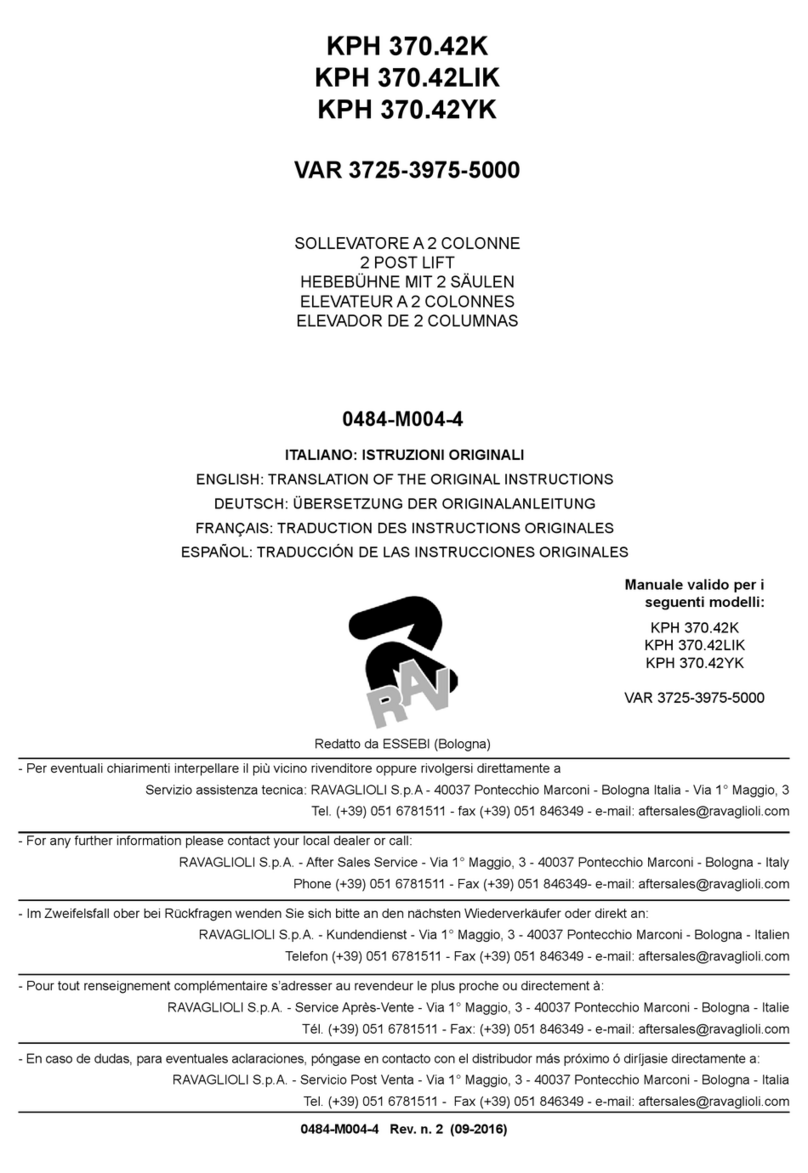
Ravaglioli
Ravaglioli KPH 370.42K Translation of the original instructions
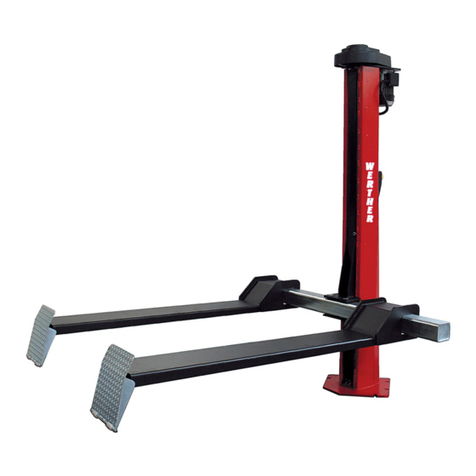
WERTHER INTERNATIONAL
WERTHER INTERNATIONAL MONOLIFT 800 manual
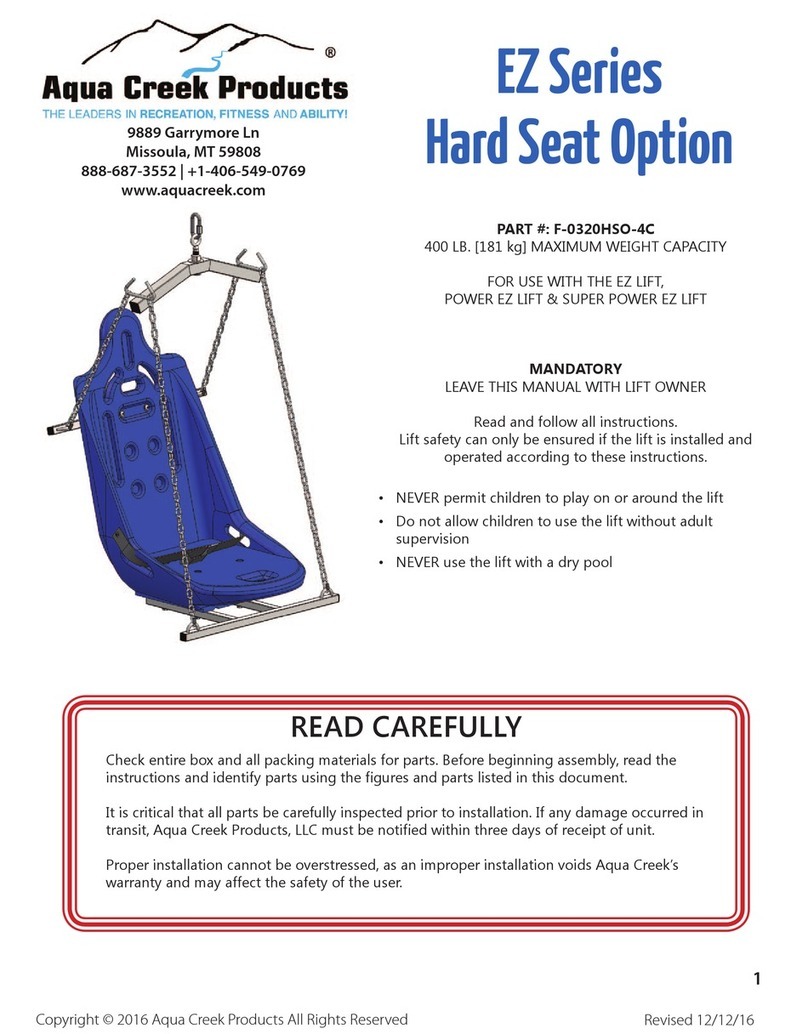
Aqua Creek Products
Aqua Creek Products EZ Series quick start guide
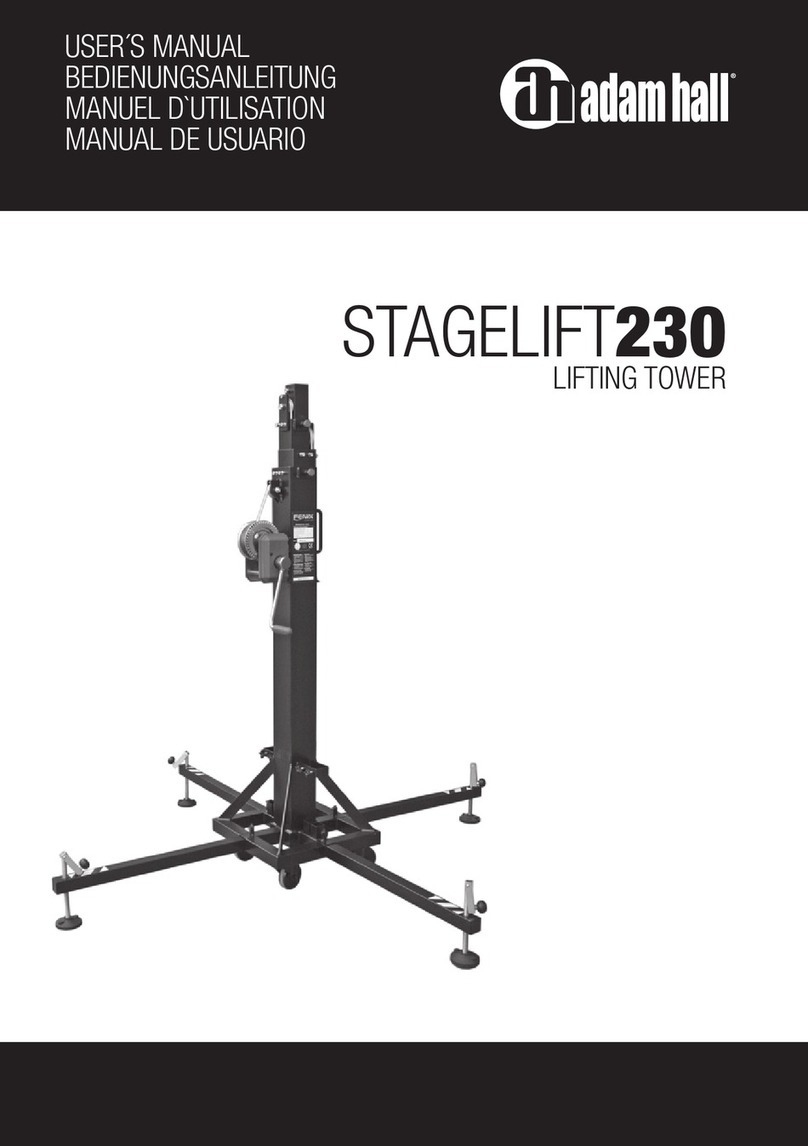
Adam Hall
Adam Hall STAGELIFT230 user manual
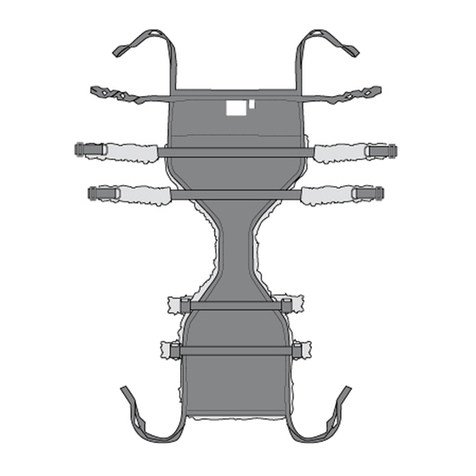
Liko
Liko Ultra LiftPants 920 Instruction guide

Vitea Care
Vitea Care DRVF02 user manual
